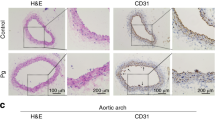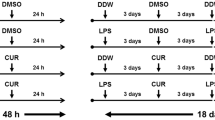Abstract
Objective
Porphyromonas gingivalis is a major periodontopathogen that plays a role in the pathogenesis of periodontal disease. In this study, we investigated the effect of 18alpha-glycyrrhetinic acid (18α-GA), a natural triterpenoid compound derived from licorice root extract, on P. gingivalis lipopolysaccharide (LPS)-induced vascular permeability, which is a hallmark of inflammatory diseases such as periodontitis.
Methods
The inhibitory effects of 18α-GA on endothelial permeability were determined by measuring in vivo and in vitro endothelial permeability. Endothelial cells were pretreated with 18α-GA before exposure to P. gingivalis LPS, and total RNA or proteins were extracted and analyzed by reverse transcription polymerase chain reaction or western blotting.
Results
Porphyromonas gingivalis LPS-induced endothelial permeability was significantly inhibited by 18α-GA both in vivo and in vitro. 18α-GA reduces P. gingivalis LPS-induced gap formation of endothelial cells. Importantly, 18α-GA modulated the expression and secretion of interleukin-8 (IL-8), a key inducer of vascular permeability, by downregulating nuclear factor-κB (NF-κB). 18α-GA suppressed P. gingivalis LPS-stimulated inhibitor of kappa B (IκB) kinase activation, IκBα phosphorylation, and nuclear translocation of NF-κB.
Conclusions
Overall, these findings suggest that 18α-GA significantly reduces P. gingivalis LPS-induced vascular permeability by repressing NF-κB-dependent endothelial IL-8 production, suggesting its therapeutic potential in P. gingivalis-related vascular diseases.




Similar content being viewed by others
References
Bostanci N, Belibasakis GN. Porphyromonas gingivalis: an invasive and evasive opportunistic oral pathogen. FEMS Microbiol Lett. 2012;333:1–9.
Jain S, Darveau RP. Contribution of Porphyromonas gingivalis lipopolysaccharide to periodontitis. Periodontol. 2000;2010(54):53–70.
Hayashi C, Gudino CV, Gibson FC 3rd, Genco CA. Review: Pathogen-induced inflammation at sites distant from oral infection: bacterial persistence and induction of cell-specific innate immune inflammatory pathways. Mol Oral Microbiol. 2010;25:305–16.
Janket SJ, Jones JA, Meurman JH, Baird AE, Van Dyke TE. Oral infection, hyperglycemia, and endothelial dysfunction. Oral Surg Oral Med Oral Pathol Oral Radiol Endod. 2008;105:173–9.
Stevens T, Garcia JG, Shasby DM, Bhattacharya J, Malik AB. Mechanisms regulating endothelial cell barrier function. Am J Physiol Lung Cell Mol Physiol. 2000;279:L419–22.
Vestweber D. Regulation of endothelial cell contacts during leukocyte extravasation. Curr Opin Cell Biol. 2002;14:587–93.
Imamura T, Pike RN, Potempa J, Travis J. Pathogenesis of periodontitis: a major arginine-specific cysteine proteinase from Porphyromonas gingivalis induces vascular permeability enhancement through activation of the kallikrein/kinin pathway. J Clin Invest. 1994;94:361–7.
de Almeida OP, Bohm GM. Vascular permeability in the rat gingiva. A model of vessel response in chronic inflammation. J Pathol. 1979;127:27–34.
Sasaki H, Suzuki N, Alshwaimi E, Xu Y, Battaglino R, Morse L, Stashenko P. 18beta-glycyrrhetinic acid inhibits periodontitis via glucocorticoid-independent nuclear factor-kappaB inactivation in interleukin-10-deficient mice. J Periodontal Res. 2010;45:757–63.
Asl MN, Hosseinzadeh H. Review of pharmacological effects of Glycyrrhiza sp. and its bioactive compounds. Phytother Res. 2008;22:709–24.
Shetty AV, Thirugnanam S, Dakshinamoorthy G, Samykutty A, Zheng G, Chen A, Bosland MC, Kajdacsy-Balla A, Gnanasekar M. 18alpha-glycyrrhetinic acid targets prostate cancer cells by down-regulating inflammation-related genes. Int J Oncol. 2011;39:635–40.
Wang CY, Kao TC, Lo WH, Yen GC. Glycyrrhizic acid and 18beta-glycyrrhetinic acid modulate lipopolysaccharide-induced inflammatory response by suppression of NF-kappaB through PI3K p110delta and p110gamma inhibitions. J Agric Food Chem. 2011;59:7726–33.
Chang YL, Chen CL, Kuo CL, Chen BC, You JS. Glycyrrhetinic acid inhibits ICAM-1 expression via blocking JNK and NF-kappaB pathways in TNF-alpha-activated endothelial cells. Acta Pharmacol Sin. 2010;31:546–53.
Weis SM. Chapter 5. Evaluating vascular leak in vivo. Methods Enzymol. 2008;444:99–114.
Kim SR, Bae SK, Park HJ, Kim MK, Kim K, Park SY, Jang HO, Yun I, Kim YJ, Yoo MA, Bae MK. Thromboxane A(2) increases endothelial permeability through upregulation of interleukin-8. Biochem Biophys Res Commun. 2010;397:413–9.
Jaffe EA, Nachman RL, Becker CG, Minick CR. Culture of human endothelial cells derived from umbilical veins. Identification by morphologic and immunologic criteria. J Clin Invest. 1973;52:2745–56.
Gavard J, Gutkind JS. VEGF controls endothelial-cell permeability by promoting the beta-arrestin-dependent endocytosis of VE-cadherin. Nat Cell Biol. 2006;8:1223–34.
Newman PJ. The biology of PECAM-1. J Clin Invest. 1997;100(11 Suppl):S25–9.
Petreaca ML, Yao M, Liu Y, Defea K, Martins-Green M. Transactivation of vascular endothelial growth factor receptor-2 by interleukin-8 (IL-8/CXCL8) is required for IL-8/CXCL8-induced endothelial permeability. Mol Biol Cell. 2007;18:5014–23.
Vestweber D. VE-cadherin: the major endothelial adhesion molecule controlling cellular junctions and blood vessel formation. Arterioscler Thromb Vasc Biol. 2008;28:223–32.
Fukumoto T, Matsukawa A, Yoshimura T, Edamitsu S, Ohkawara S, Takagi K, Yoshinaga M. IL-8 is an essential mediator of the increased delayed-phase vascular permeability in LPS-induced rabbit pleurisy. J Leukoc Biol. 1998;63:584–90.
Gavard J, Hou X, Qu Y, Masedunskas A, Martin D, Weigert R, Li X, Gutkind JS. A role for a CXCR2/phosphatidylinositol 3-kinase gamma signaling axis in acute and chronic vascular permeability. Mol Cell Biol. 2009;29:2469–80.
Wu YM, Robinson DR, Kung HJ. Signal pathways in up-regulation of chemokines by tyrosine kinase MER/NYK in prostate cancer cells. Cancer Res. 2004;64:7311–20.
Zandi E, Rothwarf DM, Delhase M, Hayakawa M, Karin M. The IkappaB kinase complex (IKK) contains two kinase subunits, IKKalpha and IKKbeta, necessary for IkappaB phosphorylation and NF-kappaB activation. Cell. 1997;91:243–52.
Darveau RP. Periodontitis: a polymicrobial disruption of host homeostasis. Nat Rev Microbiol. 2010;8:481–90.
Hashizume T, Kurita-Ochiai T, Yamamoto M. Porphyromonas gingivalis stimulates monocyte adhesion to human umbilical vein endothelial cells. FEMS Immunol Med Microbiol. 2011;62:57–65.
Park HJ, Jeong SK, Kim SR, Bae SK, Kim WS, Jin SD, Koo TH, Jang HO, Yun I, Kim KW, Bae MK. Resveratrol inhibits Porphyromonas gingivalis lipopolysaccharide-induced endothelial adhesion molecule expression by suppressing NF-kappaB activation. Arch Pharm Res. 2009;32:583–91.
Zhang D, Zheng H, Zhao J, Lin L, Li C, Liu J, Pan Y. Porphyromonas gingivalis induces intracellular adhesion molecule-1 expression in endothelial cells through the nuclear factor-kappaB pathway, but not through the p38 MAPK pathway. J Periodontal Res. 2011;46:31–8.
Koo TH, Jun HO, Bae SK, Kim SR, Moon CP, Jeong SK, Kim WS, Kim GC, Jang HO, Yun I, Kim KW, Bae MK. Porphyromonas gingivalis, periodontal pathogen, lipopolysaccharide induces angiogenesis via extracellular signal-regulated kinase 1/2 activation in human vascular endothelial cells. Arch Pharm Res. 2007;30:34–42.
Weis SM. Vascular permeability in cardiovascular disease and cancer. Curr Opin Hematol. 2008;15:243–9.
Curry FR, Noll T. Spotlight on microvascular permeability. Cardiovasc Res. 2010;87:195–7.
Weber C, Fraemohs L, Dejana E. The role of junctional adhesion molecules in vascular inflammation. Nat Rev Immunol. 2007;7:467–77.
Kocgozlu L, Elkaim R, Tenenbaum H, Werner S. Variable cell responses to P. gingivalis lipopolysaccharide. J Dent Res. 2009;88:741–5.
Hayashi C, Viereck J, Hua N, Phinikaridou A, Madrigal AG, Gibson FC 3rd, Hamilton JA, Genco CA. Porphyromonas gingivalis accelerates inflammatory atherosclerosis in the innominate artery of ApoE deficient mice. Atherosclerosis. 2011;215:52–9.
Wada K, Kamisaki Y. Roles of oral bacteria in cardiovascular diseases–from molecular mechanisms to clinical cases: involvement of Porphyromonas gingivalis in the development of human aortic aneurysm. J Pharmacol Sci. 2010;113:115–9.
Wada K, Kamisaki Y. Molecular dissection of Porphyromonas gingivalis-related arteriosclerosis: a novel mechanism of vascular disease. Periodontol 2000. 2000;2010(54):222–34.
Acknowledgments
This research was supported by College of Pharmacy-specialized Research Fund (from institute for new drug development) of Keimyung University in 2011 (to C.-H. Jeong) and by Basic Science Research Program through the National Research Foundation of Korea (NRF) funded by the Ministry of Education, Science and Technology (2010-0003750) (to M.-K. Bae).
Author information
Authors and Affiliations
Corresponding authors
Additional information
Responsible Editor: Michael Parnham.
S.-R. Kim and H.-J. Jeon are co-first authors.
Electronic supplementary material
Below is the link to the electronic supplementary material.
11_2012_560_MOESM1_ESM.ppt
Supplemental Figure 1. Immunocytochemical views of PECAM-1 with a low magnification. HUVECs incubated with P. gingivalis LPS (10 μg/ml) alone or in combination with 18α-GA (100 nM) for 12 h were immunostained for PECAM-1, and then photographed under fluorescence microscope (10X). The arrows indicate the position of the paracellular gaps
Supplemental Figure 2. Effect of recombinant IL-8 protein on paracellular gap formation in endothelial cells. HUVECs were treated with P. gingivalis LPS (10 μg/ml) or IL-8 (10 ng/ml) in the presence or absence of anti-IL-8 (1 μg/ml) and immunostained with anti-PECAM-1
Supplemental Figure 3. The schematic diagram of our proposed mechanism of the inhibitory effect of 18α-GA on the P. gingivalis LPS-induced endothelial permeability. (PPT 1894 kb)
Rights and permissions
About this article
Cite this article
Kim, SR., Jeon, HJ., Park, HJ. et al. Glycyrrhetinic acid inhibits Porphyromonas gingivalis lipopolysaccharide-induced vascular permeability via the suppression of interleukin-8. Inflamm. Res. 62, 145–154 (2013). https://doi.org/10.1007/s00011-012-0560-5
Received:
Revised:
Accepted:
Published:
Issue Date:
DOI: https://doi.org/10.1007/s00011-012-0560-5




